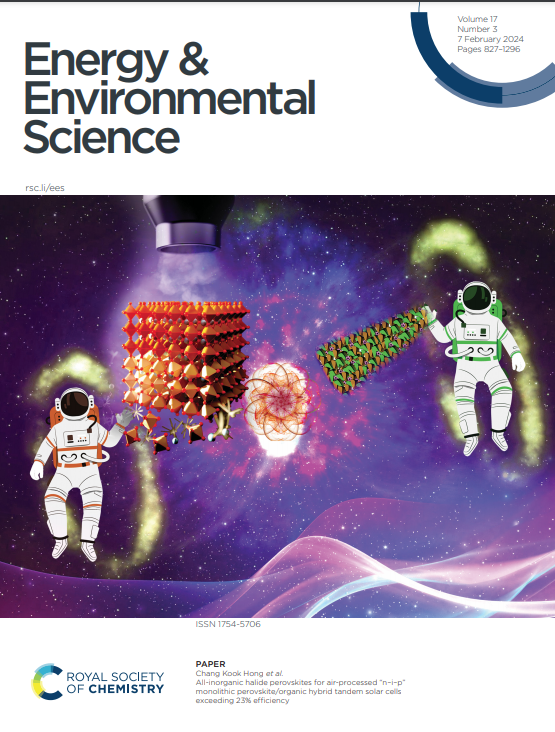Designer diffusion media microstructures enhance polymer electrolyte fuel cell performance
IF 30.8
1区 材料科学
Q1 CHEMISTRY, MULTIDISCIPLINARY
引用次数: 0
Abstract
Gas diffusion media are essential components in polymer electrolyte membrane fuel cells and a broad range of electrochemical technologies, enabling efficient mass transport of gas and liquid, electronic and thermal conductivity, and structural integrity under compression. Conventional diffusion media, typically made from carbon fiber substrates with microporous layers, have been extensively post-treated to enhance performance; however, these approaches offer limited control over three-dimensional microstructure, particularly for advanced architectures with bimodal or gradient porosity – which can facilitate multiphase gas and liquid mass transport – and often rely on complex, multi-step processes. These limitations underscore the need for scalable, cost-effective fabrication methods capable of producing much broader geometrical features. Here, we introduce a scalable, bottom-up fabrication method based on non-solvent induced phase separation (NIPS) to produce carbon-based diffusion media with finely tunable microstructures. By systematically varying processing parameters, we generate thin, mechanically robust diffusion media with tailored in-plane and through-plane porosity, including isoporous and bimodal structures. Using microscopy, porosimetry, and electrochemical diagnostics, we correlate microstructural features with single-cell fuel cell performance, revealing their impact on water management and gas transport. We further demonstrate post-treatment strategies to enhance mass transport properties and benchmark the cost and scalability of NIPS fabrication against conventional carbon fiber-based diffusion media via technoeconomic analysis. Our findings highlight the potential of NIPS as a versatile and industrially relevant pathway for next-generation diffusion media, offering new design freedoms to optimize fuel cell performance and reduce system-level costs.设计扩散介质微结构提高聚合物电解质燃料电池的性能
气体扩散介质是聚合物电解质膜燃料电池和广泛的电化学技术的重要组成部分,可以实现气体和液体的有效质量传输,电子和热导率,以及压缩下的结构完整性。传统的扩散介质通常由带有微孔层的碳纤维衬底制成,经过广泛的后处理以提高性能;然而,这些方法对三维微观结构的控制有限,特别是对于具有双峰或梯度孔隙度的高级结构,这可以促进多相气液质量的传输,并且通常依赖于复杂的多步骤过程。这些限制强调需要可扩展的、具有成本效益的制造方法,能够产生更广泛的几何特征。在这里,我们介绍了一种基于非溶剂诱导相分离(NIPS)的可扩展,自下而上的制造方法,以生产具有精细可调微结构的碳基扩散介质。通过系统地改变工艺参数,我们生成了薄的、机械坚固的扩散介质,具有量身定制的平面内和平面内孔隙率,包括等孔和双峰结构。通过显微镜、孔隙度测定和电化学诊断,我们将微观结构特征与单电池燃料电池性能联系起来,揭示了它们对水管理和气体输送的影响。我们进一步展示了后处理策略,以提高质量输运性能,并通过技术经济分析对NIPS制造的成本和可扩展性进行了基准测试,以对抗传统的碳纤维扩散介质。我们的研究结果突出了NIPS作为下一代扩散介质的通用和工业相关途径的潜力,为优化燃料电池性能和降低系统级成本提供了新的设计自由度。
本文章由计算机程序翻译,如有差异,请以英文原文为准。
求助全文
约1分钟内获得全文
求助全文
来源期刊

Energy & Environmental Science
化学-工程:化工
CiteScore
50.50
自引率
2.20%
发文量
349
审稿时长
2.2 months
期刊介绍:
Energy & Environmental Science, a peer-reviewed scientific journal, publishes original research and review articles covering interdisciplinary topics in the (bio)chemical and (bio)physical sciences, as well as chemical engineering disciplines. Published monthly by the Royal Society of Chemistry (RSC), a not-for-profit publisher, Energy & Environmental Science is recognized as a leading journal. It boasts an impressive impact factor of 8.500 as of 2009, ranking 8th among 140 journals in the category "Chemistry, Multidisciplinary," second among 71 journals in "Energy & Fuels," second among 128 journals in "Engineering, Chemical," and first among 181 scientific journals in "Environmental Sciences."
Energy & Environmental Science publishes various types of articles, including Research Papers (original scientific work), Review Articles, Perspectives, and Minireviews (feature review-type articles of broad interest), Communications (original scientific work of an urgent nature), Opinions (personal, often speculative viewpoints or hypotheses on current topics), and Analysis Articles (in-depth examination of energy-related issues).
 求助内容:
求助内容: 应助结果提醒方式:
应助结果提醒方式:


